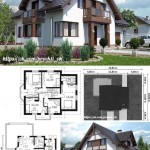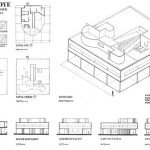Building a Home: Floor Plans
A floor plan serves as the blueprint for a home, dictating the layout, size, and flow of the living spaces. Careful consideration of the floor plan is crucial during the design phase as it significantly impacts the functionality, aesthetics, and overall livability of the home. A well-designed floor plan optimizes space utilization, maximizes natural light, and fosters a comfortable and efficient living environment.
Key Considerations When Designing a Floor Plan
Several key factors influence the creation of an effective floor plan. Understanding these elements helps ensure the final plan aligns with the homeowner's lifestyle and needs.
Lifestyle and Needs
The first step in designing a floor plan is to assess the lifestyle and needs of the occupants. Consider the number of bedrooms and bathrooms required, whether a dedicated home office is necessary, and the desired size and layout of common areas like the living room and kitchen. Families with young children may prioritize a playroom or a large family room, while those who entertain frequently may require a formal dining room or a spacious outdoor patio.
Lot Size and Orientation
The size and orientation of the lot play a significant role in shaping the floor plan. The lot's dimensions determine the maximum footprint of the house, while the orientation affects the placement of windows and doors to maximize natural light and ventilation. A south-facing lot, for example, offers ample sunlight and can be leveraged for passive solar heating. Steep slopes or irregularly shaped lots present unique design challenges that must be addressed in the floor plan.
Budget
The construction budget is a critical constraint that influences the size and complexity of the floor plan. Larger homes with intricate designs and high-end finishes are more expensive to build. Working within a predetermined budget requires careful planning and prioritization of features. It may involve making trade-offs between size, finishes, and architectural details.
Building Codes and Regulations
Local building codes and regulations dictate specific requirements for floor plans, including minimum room sizes, ceiling heights, and setback requirements. Adherence to these codes is essential to ensure the safety and legality of the construction project. Consulting with local authorities and experienced architects is crucial to navigate these regulations effectively.
Flow and Functionality
The flow of a floor plan refers to how easily one can move between different spaces within the home. A well-designed floor plan promotes a natural and intuitive flow, minimizing wasted space and maximizing efficiency. Consider the relationship between different rooms and how frequently they will be used. For instance, placing the kitchen adjacent to the dining room facilitates serving meals, while locating bedrooms away from high-traffic areas promotes privacy and quiet.
Natural Light and Ventilation
Maximizing natural light and ventilation enhances the comfort and energy efficiency of a home. Strategically placed windows and skylights can bring in natural light, reducing the need for artificial lighting during the day. Proper ventilation helps regulate temperature and humidity, improving indoor air quality. Consider the prevailing winds and sun angles when designing the placement of windows and doors to optimize natural light and cross-ventilation.
Accessibility and Future Adaptability
Designing a floor plan with accessibility in mind is essential for accommodating individuals with disabilities or mobility limitations. Wider doorways, ramps, and accessible bathrooms ensure that the home remains usable for occupants with changing needs. Considering future adaptability is also important. A flexible floor plan can accommodate changing family dynamics, such as the addition of family members or the need for a home office.
Types of Floor Plans
Several common types of floor plans cater to different lifestyles and preferences. Understanding these different layouts aids in selecting the most suitable design for a specific project.
Open Floor Plans
Open floor plans feature large, interconnected spaces, often combining the living room, dining room, and kitchen into a single area. This design promotes a sense of spaciousness and facilitates social interaction. However, it can also present challenges in terms of noise control and privacy.
Closed Floor Plans
Closed floor plans feature distinct, separate rooms, offering greater privacy and noise control. This traditional layout provides a sense of formality and can be more suitable for families who prefer designated spaces for different activities.
Split-Level Floor Plans
Split-level floor plans utilize staggered levels to create distinct zones within the home. This design can be effective in maximizing space on a sloped lot and can offer a visual separation between public and private areas.
Creating a well-designed floor plan is a crucial step in the home-building process. It requires careful consideration of various factors, including lifestyle, budget, and building codes. By understanding these key elements and exploring different floor plan types, individuals can develop a plan that meets their specific needs and creates a comfortable and functional living environment.

Easy To Build Houses And Floor Plans Houseplans Blog Com

Easy Home Building Floor Plan Cad Pro

Easy To Build Houses And Floor Plans Houseplans Blog Com

House Plans How To Design Your Home Plan

Metal House Floor Plans Steel Manufactured Homes Prefab Barndominium

How To Read A Floor Plan With Dimensions Houseplans Blog Com

Floor Plan Creator And Designer Free Easy App

Open Floor Plans Creating A Breathable Livable Custom Home Builders Schumacher Homes

Floor Plans Learn How To Design And Plan

How To Read A Basic Floor Plan Lofty Building Group








